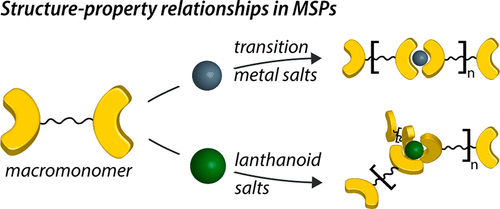当前位置:
X-MOL 学术
›
Macromolecules
›
论文详情
Our official English website, www.x-mol.net, welcomes your feedback! (Note: you will need to create a separate account there.)
Structure–Property Relationships of Microphase-Separated Metallosupramolecular Polymers
Macromolecules ( IF 5.5 ) Pub Date : 2020-07-01 , DOI: 10.1021/acs.macromol.0c00876 Laura N. Neumann 1 , Ilja Gunkel 1 , Amber Barron 1 , Emad Oveisi 2 , Albrecht Petzold 3 , Thomas Thurn-Albrecht 3 , Stephen Schrettl 1 , Christoph Weder 1
Macromolecules ( IF 5.5 ) Pub Date : 2020-07-01 , DOI: 10.1021/acs.macromol.0c00876 Laura N. Neumann 1 , Ilja Gunkel 1 , Amber Barron 1 , Emad Oveisi 2 , Albrecht Petzold 3 , Thomas Thurn-Albrecht 3 , Stephen Schrettl 1 , Christoph Weder 1
Affiliation

|
The structural, thermomechanical, and viscoelastic properties of metallosupramolecular polymers (MSPs) can be controlled through the choice of the multiligand monomer and the nature of the metal salt from which these materials are assembled. This versatility and the dynamic nature of certain metal–ligand (ML) complexes make MSPs very interesting for the design of stimuli-responsive materials. We here report on the investigation of the structure–property relationships of MSPs based on a macromonomer formed by terminating telechelic poly(ethylene-co-butylene) (PEB) with 2,6-bis(1′-methylbenzimidazolyl)pyridine (Mebip) ligands and transition metal or lanthanoid salts. The nature of the metal ion (Zn2+, Fe2+, Tb3+, La3+, or Gd3+), the counterion (trifluoromethanesulfonate (OTf–), perchlorate (ClO4–), or bis(trifluoromethylsulfonyl)imide (NTf2–)), and the number-average molecular weight (Mn) of the PEB core (2100 or 3100 g mol–1) were systematically varied with the aim to provide an improved understanding of how these parameters influence the properties. In all MSPs, the polar ML complexes and the nonpolar PEB were found to microphase separate into lamellar or hexagonal morphologies with a soft PEB phase and a ML hard phase. The microstructure formation and the mechanical properties were significantly influenced by the coordination geometry of the metal–ligand complexes as well as the volume fraction of the ML phase. The nature of the metal and counterions further affected the glass or melting transitions of the hard phase. In general, lower softening temperatures were observed for the MSPs made with lanthanoid salts. Measurements of the frequency-dependent oscillatory shear moduli were used to study the relaxation processes in the different MSPs and allowed determining the activation energy of the ML complexes in lanthanoid-based MSPs.
中文翻译:

微相分离的金属超分子聚合物的结构-性能关系
可以通过选择多配位体单体和组装这些材料的金属盐的性质来控制金属超分子聚合物(MSP)的结构,热力学和粘弹性。这种多功能性和某些金属-配体(ML)配合物的动态性质使MSP对于刺激响应材料的设计非常有趣。我们在此报告了基于大分子单体的MSP的结构-性质关系的研究,该单体是通过将远螯聚(乙烯-共-丁烯)(PEB)与2,6-双(1'-甲基苯并咪唑基)吡啶(Mebip)配体终止而形成的和过渡金属或镧系元素盐。金属离子(Zn 2 +,Fe 2 +,Tb 3+,La 3+或Gd 3+),抗衡离子(三氟甲磺酸盐(OTf –),高氯酸盐(ClO 4 –)或双(三氟甲基磺酰基)酰亚胺(NTf 2 –))和PEB的数均分子量(M n)核心(2100或3100 g摩尔–1)进行了系统地更改,目的是为了更好地了解这些参数如何影响属性。在所有MSP中,发现极性ML配合物和非极性PEB微相分离为具有软PEB相和ML硬相的层状或六边形形态。金属-配体配合物的配位几何形状以及ML相的体积分数极大地影响了微观结构的形成和力学性能。金属和抗衡离子的性质进一步影响了硬相的玻璃或熔融转变。通常,使用镧系元素盐制得的MSP的软化温度较低。
更新日期:2020-07-14
中文翻译:

微相分离的金属超分子聚合物的结构-性能关系
可以通过选择多配位体单体和组装这些材料的金属盐的性质来控制金属超分子聚合物(MSP)的结构,热力学和粘弹性。这种多功能性和某些金属-配体(ML)配合物的动态性质使MSP对于刺激响应材料的设计非常有趣。我们在此报告了基于大分子单体的MSP的结构-性质关系的研究,该单体是通过将远螯聚(乙烯-共-丁烯)(PEB)与2,6-双(1'-甲基苯并咪唑基)吡啶(Mebip)配体终止而形成的和过渡金属或镧系元素盐。金属离子(Zn 2 +,Fe 2 +,Tb 3+,La 3+或Gd 3+),抗衡离子(三氟甲磺酸盐(OTf –),高氯酸盐(ClO 4 –)或双(三氟甲基磺酰基)酰亚胺(NTf 2 –))和PEB的数均分子量(M n)核心(2100或3100 g摩尔–1)进行了系统地更改,目的是为了更好地了解这些参数如何影响属性。在所有MSP中,发现极性ML配合物和非极性PEB微相分离为具有软PEB相和ML硬相的层状或六边形形态。金属-配体配合物的配位几何形状以及ML相的体积分数极大地影响了微观结构的形成和力学性能。金属和抗衡离子的性质进一步影响了硬相的玻璃或熔融转变。通常,使用镧系元素盐制得的MSP的软化温度较低。


























 京公网安备 11010802027423号
京公网安备 11010802027423号